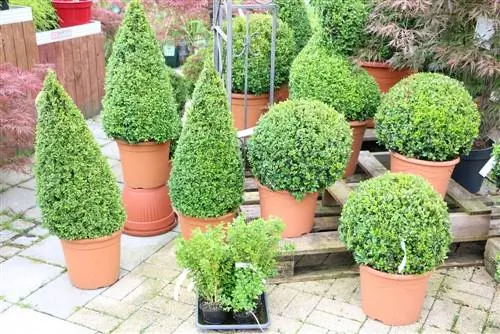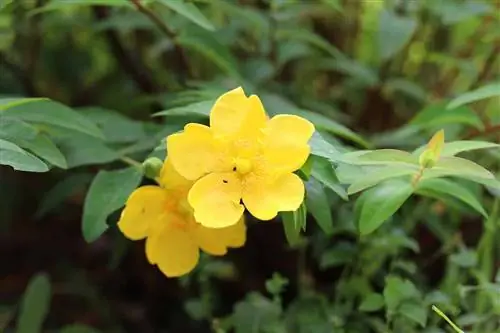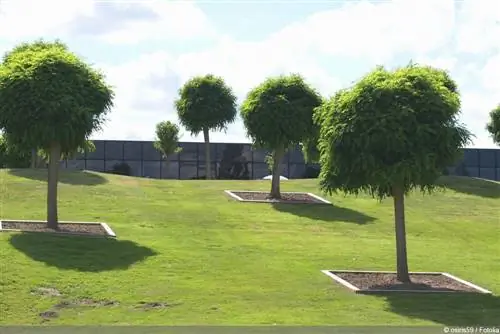- Author admin [email protected].
- Public 2023-12-17 03:39.
- Last modified 2025-01-24 12:45.
Evergreen ball trees beautify the front garden all year round with dense foliage. In addition, their growth height is limited compared to other trees, especially with the refined forms. Since evergreen trees do not shed their leaves in autumn, caring for them and cleaning the site are much easier. Thanks to the hardy properties of the ball trees, planting is also possible at higher altitudes.
Boxwood
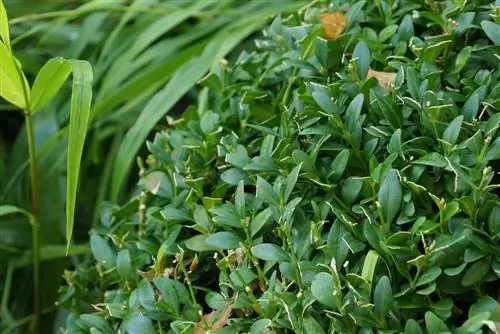
The boxwood has the botanical name Buxus sempervirens and is ideal for planting in the front garden. Most boxwood species grow very slowly, making them ideal for locations with limited space. In addition, the plant only needs a few nutrients compared to other trees. The Mediterranean plant is very robust and can tolerate different site conditions, in extreme cases even full sun. If it is very warm for a long period of time and there is no precipitation, the boxwood will appreciate an occasional shower so that the dust is washed off the leaves. However, boxwoods are sensitive to diseases. A harmful fungus in particular causes a lot of trouble for the plant.
- Extremely easy to care for plant
- Prefers locations in shade or partial shade
- Ideal as an evergreen border in the front garden
- Alternatively can be cultivated as a single plant in a bucket
- Can be cut into a living sculpture
- Prune regularly
- Can withstand even extremely strong pruning
- Even grows green leaves inside
- Fertilize with lime, iron and horn shavings
- Susceptible to fungal diseases
Mock cypress
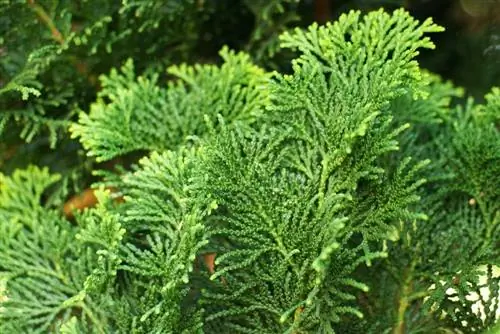
The false cypress has the botanical name Chamaecyparis lawsoniana and remains green even in winter. Due to its strong growth characteristics, the conifer can be easily shaped into a ball tree, both as a solitary plant and in the background for borders in the front garden. If pruning is neglected, the extremely vigorous tree will be difficult to tame. This must be carried out specifically, otherwise the tree will become bald from the inside out. Since the natural growth habit tends to be higher and longer, special templates are available for the shape-giving pruning. The more sunshine the false cypress receives at the location, the more magnificently it will thrive and grow. Too much shade leads to stunted growth in the long term and also significantly reduces the life expectancy of the tree. In addition, the plant is very undemanding in terms of care and soil.
- Needs a sunny to full sun location in wind-protected locations
- Can also cope with light partial shade at times
- Fresh, humus-rich and slightly moist soil is ideal
- Doesn't tolerate lime particularly well
- Avoid waterlogging at all costs
- Can be easily shaped into the desired spherical shape with targeted cutting
- Grows very quickly, 10 cm to 20 cm per year
- Pruning must be done frequently
- Stencils for the spherical shape are available from specialist retailers
- Work compost into the soil several times throughout the year for fertilization
- Winter hardy, but does not tolerate extreme temperatures below zero
- Younger specimens enjoy additional winter protection
Cherry Laurel Tree
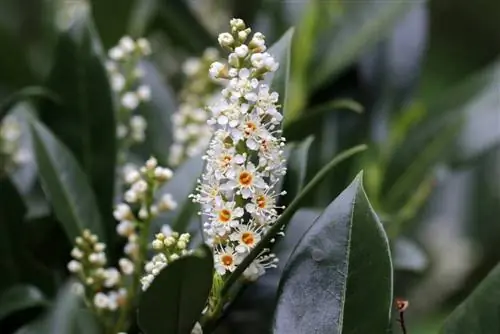
The evergreen cherry laurel tree is known in botany as Prunus laurocerasus and is often found in home gardens. Alternatively, the plant is also called bay cherry and is related to cherries and plums. The tree is often grown as a hedge because it tolerates pruning very well. As a tree, however, it grows very sprawling and can therefore be easily cut into a spherical shape. The tree fits perfectly into front gardens with a Mediterranean design, as it looks very similar to the laurel. The cherry laurel tree has few demands on care, location and soil. The laurel cherry can also be planted under other trees as they can deal well with competition. The deep-rooted plant even grows well in the densely developed root network of larger tree neighbors.
- Very easy to care for ball tree
- Fast growing tree with strong vigor
- Grows into a stately tree without pruning
- Older specimens reach heights of up to 4 m
- Needs regular pruning in the front yard
- Bring into the desired shape at the end of June
- Has dark green and shiny leaves
- Prefers sunny to partially shaded locations that are protected from the wind
- Sandy to loamy soils with fresh, moist properties are ideal
- However, does not tolerate waterlogging
- Very tolerant of limescale
- Extremely frost hardy, can also tolerate temperatures below zero
- Seeds are poisonous to humans
Ball Ginkgo
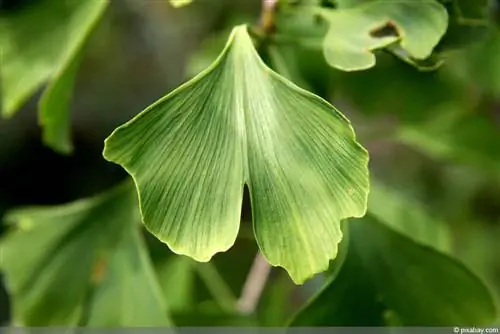
The ball ginkgo is botanically called Ginkgo biloba 'Mariken' and, with its exotic leaf shape, brings a Japanese ambience to your front garden. The tree grows very slowly and is therefore well suited to limited locations. It is also robust and easy to care for, and it can also tolerate the sub-zero temperatures here in winter. The crown grows on its own in a spherical shape, so special cutting measures are not necessary at the beginning to form and then maintain it. However, slightly older specimens should be pruned in order to achieve targeted rejuvenation of the tree crown. Since the tree develops deep roots, damage to beds and garden paths is not to be expected. Due to its resilient properties, the ball ginkgo is only slightly susceptible to pest infestation, as well as to the outbreak of typical tree diseases.
- Grows compact and spherical
- Reaches a total height of 3 m
- Can cope with sunny to shady locations
- Adapts to most soil qualities
- Soil with a high nutrient content is optimal
- Water additionally in case of prolonged drought
- Soil should never dry out completely
- It bears rather inconspicuous fruits and flowers
- Leaves form fan-like structures
- Hardy, but only summer green
- In autumn the leaves turn bright yellow
- Very pruning-friendly tree
Ball locust tree
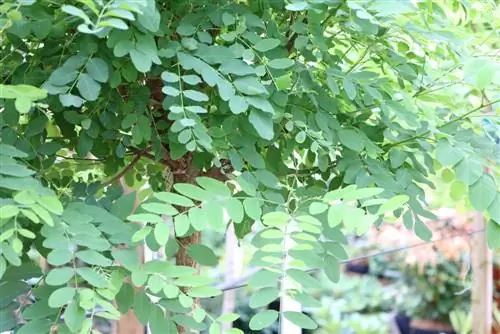
The ball robinia has the botanical name Robinia pseudoacacia “Umbraculifera” and grows quickly in height. That's why the plant is well suited for larger front gardens that offer it enough space. This tree is ideal if you want privacy and soundproofing from the street. Over time, the diameter of the trunk continues to increase, even when the total height has already been reached. Over the years, the size of the crown also increases, so periodic pruning is necessary. This should be cut above the finishing point, otherwise the rootstock can sprout again. In this way, the desired spherical shape can still be maintained. The ball locust is not very demanding when it comes to care, but freshly planted plants should be watered until they are firmly established.
- Particularly fast-growing tree
- Reaches total heights of up to 4 m
- Forms feathery leaves with decorative autumn colors
- Foliage glows yellow, golden brown or red in autumn
- Prefers sunny and wind-protected locations
- Substrate can be dry to moist
- However, does not tolerate waterlogging, create drainage in the ground
- Can cope with clay soils as well as sandy and gravel soils
- Permeable soil that is rich in nutrients is ideal
- Planting possible all year round, except on frosty days
- Fertilize with compost in spring
- Extremely cut-friendly, easy to shape into a ball shape
- Woods are very poisonous, be careful with children and pets

